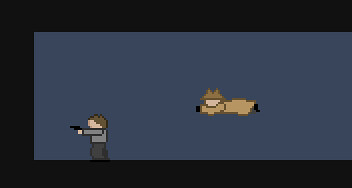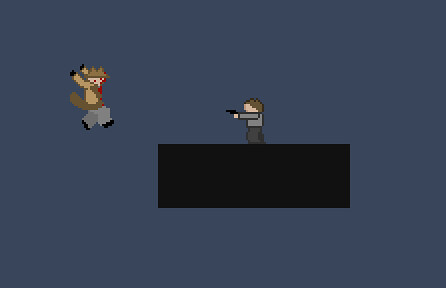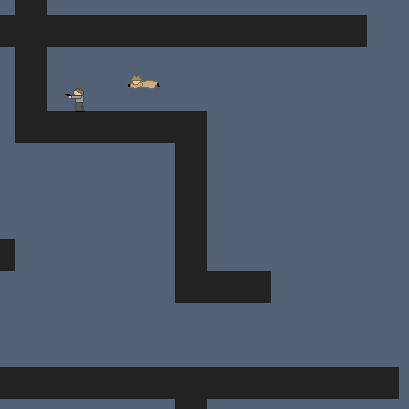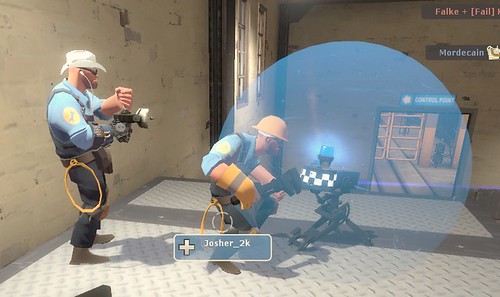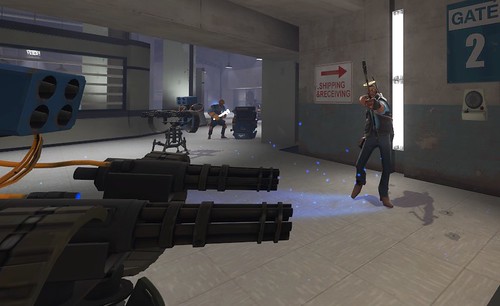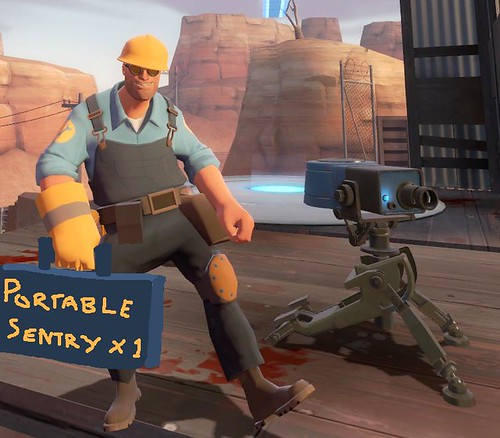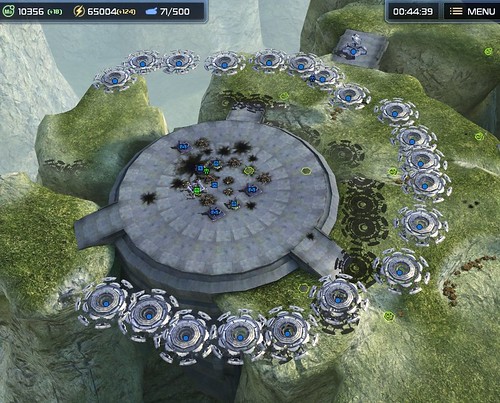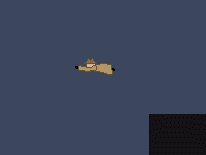TOM FRANCIS
REGRETS THIS ALREADY
Hello! I'm Tom. I'm a game designer, writer, and programmer on Gunpoint, Heat Signature, and Tactical Breach Wizards. Here's some more info on all the games I've worked on, here are the videos I make on YouTube, and here are two short stories I wrote for the Machine of Death collections.
Theme
By me. Uses Adaptive Images by Matt Wilcox.
Search
Gunpoint: Making The Jump
I had a chance to work on my game in my week off, the one I was going to call Private Dick. That name is increasingly pissing me off, so I’m calling it Gunpoint for now. How relevant that title becomes will depend a bit on how much fun it really is to be at gunpoint, or have other people there, and what kind of options I can reasonably code for those situations. Currently everyone with a gun shoots you in the face the instant they see you, and there’s a certain comforting reliability in that.
I’m almost at Milestone 2 – they’re really yard stones, these things, because I can’t have spent much more than ten hours on this thing since Milestone 1. Here’s the plan:
Milestone 1: movement fully working, however horrible it looks and shitty it feels.
Milestone 2: one hostile who shoots on sight, and can be pounced on and beaten unconscious.
Milestone 3: two devices that are interactible. I’ll talk about devices once I’ve got them working.
Milestone 4: one fully working level that’s fun.
Milestone 5: a dialogue system why not?
Milestone 6: narrative reduces grown men to hopeless fits of sobbing.
Milestone 7: the Citizen Kane of games.
So I’m not really thinking clearly more than two or three milestones ahead – my plans change too much with each one for that to be worthwhile, and anyway it’s kind of daunting.
About ten of the people who signed up to test my game played Milestone 1 and told me what they thought of it. This was awesome. Not least because most thought it was a lot less horrible-looking and shitty-feeling than I was expecting.
It’s also a really exciting and eye-opening thing to have people interact with something you created, and have reactions you didn’t expect. People overwhelmingly wanted a certain move added that I’d intentionally left out. And they were right: I’ve added it now and it profoundly improves the feel of the game.
That milestone was all about the jump: the tiny freelance agent you play can leap preposterous distances in any direction, and cling to anything he hits. This milestone, number 2, is about using that jump to pounce on angry gunmen while they’re not looking, then punching them in the face while you have them pinned to the ground.
That part took minutes, really, and is immediately and profoundly enjoyable. I hadn’t really thought about it before I coded it, but there’s no reason to force the player to let the gunman go after he’s hit him in the face once. I just made the mouse click smack him in the face, then return to the about-to-smack-him-in-the-face pose. You can jump off if you like, but in a survey of playtesters called me, 100% felt the need to beat him again and again and again, sometimes tapping out semi-musical rhythms with their facebeatings.
What was trickier was making the jump good enough that you could bet your life on it. One of the biggest complaints from the first test, even without any threats, was that people had trouble judging where their jump would go. I hadn’t even put a charge-meter in, and the strength of your jump increased quadratically as you held the button. A player’s instinctive grasp of basic movement mechanics doesn’t necessarily model quadratics effectively.
This was not a surprise. I knew what I wanted, ideally: a visual projection of the exact arc your jump will take. But like most of my plans, I had a few much easier back ups that wouldn’t work as well. Any kind of charge meter, I thought, would probably do.
The reason I’ve only spent ten hours working on this since the last milestone 5 weeks ago is not actually free time. It’s guts. Doing everything yourself is sometimes daunting.
The fun stuff: design, requires some less fun and harder stuff: coding. And the still quite fun stuff: coding, requires some much less fun, much harder and miserably unsatisfying stuff: art. When I’m not working on my game, it’s because I’m exhausted or distracted or just not in the mood to take on something that may, at any time, kick my ass.
What I’ve learnt from the whole process is this: guts. I’m not accustomed to putting time and effort into something and having it turn out shit, but I’ve found that when I actually get down and do it, it doesn’t take that much time and effort and not everyone thinks it’s shit. Just do it. Accept that not everything you do is going to be met with a steady stream of praise, venture outside your comfort zone and grow up.
That’s true enough for art, but it’s particularly true for coding. Predicting the arc of a player’s jump meant simulating the engine’s own internal vector analysis precisely, so that I could do all the calculations involved with it in a single frame. In other words, the game would have to play the jump out in its head thirty times a second, exactly the same way it would happen at normal speed. It seemed like it would involve an awful lot of trigonometry, which is tricky to code and tricky to compute. Having the game do it thirty times a second seemed like it would destroy performance.
Long story short, it was easy. If you’re smart about it, no sines, cosines or tangents are needed, just basic multiplications. It’s high school mathematics to model a rigid body under acceleration and derive a generalised formula for its position. And once you’ve got that, you just plug increasing values of time into it and create a dot at that position until you hit something. There are ways to make it more precise and reliable, but it already works so well that it’s completely changed the way I play.
I still don’t have a charge meter – I changed the system so that if you want to go further, you just click further away. It means you can make small, precise jumps without time pressure, and great long arcing ones without delay. And it feels great to leap six stories, through a window, and into the back of someone’s head. Then punch them to the beat of Seven Nation Army.
I whined a while ago about wanting to get to the point where the question is “Is this fun?” rather than “Why doesn’t this fucking, fucking work?” I’m there now, and from here until I’m done with the game or give up on it, there’ll always be “Is this fun?” questions to answer. There’ll still be many more things that don’t fucking, fucking work, but I’m tantalisingly close to having most of the building blocks to make real levels out of. Once I’m there, it gets really interesting.
Edit: just as I finish this, Sophie Houlden posts the text of her talk at World of Love, and it’s basically telling me to realise what I just realised.
Edit 2: Once I’ve tweaked it a bit, I could use some more testers to help me figure out if this iteration is fun yet. Any more volunteers? Mail me if so.
Edit 3: Now with animated gif.
Valve Steal Most Of Tom’s Evening
Engineer night was horrific. I haven’t seen this many stalemates since Hydro. Everyone’s desperate for the new unlocks, but the achievements that unlock them either require the unlocks, or are based around Engineering in the context of a normal game. Stuff like supporting a Heavy while he mows people down. When your friends and opponents are all just static installations of angry metal gun, there’s not a lot of scope for that.
For the lucky few who got them, the new unlocks looked amazing. You can Wrangle a Gunslung Combat Sentry, so your damage boost negates its reduced damage output, your shield negates its level 1 hitpoints, and your beam gives it seemingly infinite range. It’s as ridiculous as that collection of words.
In the end, none of the individual unlocks matched the specs of any of my suggestions closely enough to justify my mock accusations of plagiarism. But the set of abilities these give you – deploy small sentries quickly, move them, shield instead of repair, and direct their fire manually – is just what I wanted from mine. If I ever actually earn the damn things, I’ll be extremely happy.
Day Off
Built twenty Darkenoid saucers to create a laser embargo around the AI while I stole everything they built with a Loyalty Cannon.
Valve Steal Third And Fourth James Weapon Ideas
Not really, of course: the newly announced Wrangler is a more intricate beast than my Laser Pointer or Shield Spanner suggestions. It sounds ridiculous: not only do you get to direct your Sentry’s fire, but it’s also nigh-impervious to harm and twice as powerful. But of course, if you’re using the Wrangler, you’re not using your Wrench. So your Sentry isn’t getting healed, and it has to shut down for three seconds if you whip out your spanner.
I won’t pretend to know how this will play out, but I actually think this is how Sentries should always have been. There should be no auto mode. Having the AI spot and shoot human players robs the Engy of the satisfaction of doing it himself, and the victim the knowledge that they were caught out by a real opponent. Instead, a computer has all the fun, and the players it kills don’t learn much: the computer simply out-damaged them. Most of the time I die to a Sentry, my only other option was to hang back and do nothing.
So I’m glad the Wrangler sounds crazy powerful, because I’d like everyone to use it, all the time. I’d rather have a tougher but fallible opponent, and one that doesn’t rapidly self-heal, than the alternative.
I’m taking some time off at the moment (which will hopefully translate to some progress with Private Dick), but Jaz and the guys have been running an amazingly good days-long liveblog of every snippet of information that’s come out about the Engineer update.
PC Gamer Has Been Allowed Onto The Internet
We tried an experiment a while back, where we suddenly started putting our hearts and souls into our little corner of computerandvideogames.com to see if a) we could do it, b) people would like it, and c) people would like something more. We could and they did and they would.
This information was then fed into a much larger and darker decision-making process that I had really nothing to do with, the first stage of which acts a little like a paper shredder, but it eventually resulted in us getting a site anyway.
We have wanted this very badly for a very long time and worked very hard to get it. So, thank you to all who responded to my thinly veiled call for you to express deep dissatisfaction with our previous web presence, and welcome to our new one.
Since Tim was away at E3, I was in charge of the site launch, and Graham helmed the magazine. It’s been a frantic… Christ, one week? Feels like a month. It’s been a frantic week in which we’ve put up over a hundred and fifty articles, so I thought I’d highlight some of the stuff I’m most pleased with so far.
- Project Dust
This was the first time I read news I did not know on our own site, and it happened to be the most surprising and interesting reveal of E3. It’s also great to see something exciting like that and not have the “But is it coming to PC?” anxiety. It’s on our site, so yes.
- Gaming’s best cereal-based shooter
Evan’s wonderfully uncynical look at a piece of Americana I’d heard of but really knew nothing about, and the bizarre surrounding culture.
- 20 beautiful new Brink shots
This just makes me happy because it’s just not something we could do effectively before, and it looks superb on the page. It was a personal quest of mine to ensure that whenever we showed off screenshots, you’d just have to click them to get straight to the full, high-res, clean, unwatermarked original file.
- Transformice
Jaz’s post is a great statement of the kind of free game coverage I’ve always wanted. To me, “Here’s a free game that’s mildly entertaining for thirty seconds” is not news – I can see ten of those a day on sites dedicated to that stuff. If we’re talking about one in particular, I want to know why, ideally in the form of a funny story about what happened while playing it.
- Engineering victory in Supreme Commander 2
After helping us out for two crucial weeks, Tom Senior surprised us all by writing his best piece (that I’ve read) on his last day. A great guide to a hilarious tactic with truly magnificent screenshots. I can always tell when someone’s writing about something they know and love, because it’s the only kind of article I can read through without wanting to change anything – the writing just clicks.
- Microsoft’s shameful E3 PC showing
This is why I like having Tim as an editor. At PC Gamer we’re lucky enough to carry some authority without being an official mag beholden to anyone, so when someone screws over our platform, we can say so in no uncertain terms. No-one more so than Tim. I’ve always been proud of PC Gamer’s history of eloquent indignation: I think we do a good job of standing up for gamers without sounding whiny or getting hysterical. Rants are commonplace online, good rhetoric is not.
Controlling the launch madness means most of the really substantial stuff I’ve contributed is what I wrote ahead of time – namely a week of Deus Ex and Deus Ex 3 features. It’s been an interesting prototype of how we can provide really nerdily detailed coverage of a hugely exciting game in both the magazine and the website, without rendering either one redundant.
In both the UK and the US, the mag carries a six-page feature that has all the juicy information and probably the best summary of why Human Revolution is worth getting excited about. It has more screenshots and art than have been released online, and it came out well before anyone was allowed to say word one about the game on the web.
On the site, you get the full interviews it was based on, a blow-by-blow account of exactly what I saw and what I thought of it, some informal chatting about the art, and a reminder or two of what we loved about the original. It’s almost the opposite of conventional wisdom about the web versus print: the web’s supposed to be quick and brief, but I think it can be a place where people get to choose the level of depth they want. Print’s sometimes characterised as long-form and slow, but here it’s faster and punchier at presenting the juicy details.
The blow-by-blow in particular was really fun to write. It’s an attempt to address two of my most common frustrations with previews: “Stop wanking and tell me what you saw,” and “Don’t just tell me what you saw, tell me what you thought of it.” Writing it like a liveblog presented a really convenient format for getting facts and impressions side by side without a lot of structural wrangling to fit it into flowing prose.
Of the interviews, I think the one with art director Jonathan Jacques-Belletete stands up best on its own. Knowing I’d also be talking to the game design and story people separately freed me up to ask some more wide-ranging stuff, and see where the discussion went. And I really liked how honest he was when I asked about the risk of going obviously futuristic when that was so badly received in Invisible War.
Big thanks to Lewis Denby and Jaz for their help getting the interviews into electrowords.
I am now profoundly exhausted, so please be nice. The feedback so far has been amazing, but what remains to be seen is whether people who like these articles will take the time to link them on their weblogs, forumhaunts and Facetwitters. We finally have the chance to live or die by the quality of our stuff, so now we work overtime to make it as good as we can – and see who notices.
Finally, On Lost
Man, there was a time when Lost was so exciting I’d blog about it here. When a series loses its way, as pretty much all of them have to in the merciless American format of multiple seventeen-hour seasons, it’s amazing how quickly it wipes your memory of how good it used to be. I was a Heroes fanboy, once. Continued
Art Failure
I put it off for as long as I could, but after a quick prototype for Solo Trenchcoat Triathalon proved inconclusive, I had to put a second character in my game. This meant picking an art style, which was a problem for two reasons. For one, games aren’t art, and I know from contacts in the industry that professional game artists devote a good few hours of every working day to wrestling with this contradiction. And for another, the only acceptable sprite I’d drawn so far – protagonist Mr Conway – has his proportions and body shape completely concealed by an oversized, nebulous trenchcoat.
I am not an art guy. I feel visually dyslexic when I try to draw: I know the right shape when I see it, but I can’t visualise which pixel I need to change to make this deformed mess become that – even when it really is just one pixel. So I really struggle to depict what’s supposed to be going on under that trenchcoat. I have drawn Conway’s head big, monstrously big, a hangover from when he was to be a horrible space robot ineptly disguised as a human. Are his limbs similarly bloated? Can I really draw a head of that size without disguising it beneath a stylish hat? Can I balance a head of that size on a human body? Can I just set my game in a world where it’s considered indecent not to wear a trenchcoat?
All these things are problems because they resulted in this:
An armless, morose John Hodgman who just looks fat, awkward and wrong. Despite general murmurings of support on Twitter for the idea of a nightmarish Being John Hodgman world, I could see this wasn’t going to get good any time soon, so went in a completely different direction:
This would be a complete rethink, requiring a new treatment of the main character (not this douche), and a much more realistically-proportioned look. It might seem like more work, but stuff like this can be done pretty easily from photo reference. In fact, the fewer pixels you have to work with, the more artistry it takes to evoke something with them.
The trouble was Conway. Just as it was hard to extract a convincing human from the murky depths of his coat, it was almost impossible to drape the murky depths of his coat on a convincing human. Several takes ended up looking like Rincewind. And losing the outlines seemed to make every camel hue I picked for him look more and more like some kind of awful beige velour. I got as far as this before declaring it hopeless:
Doing a realistic-shaped guy from photo reference confirmed something I never realised about game art before I tried to butcher some myself: proportions, shape, size, colour, detail and expression are almost completely irrelevant. The thing that defines the feel of a character is pose. That’s why I haven’t been able to get rid of that lame original Conway sprite: everything about it is feeble and misjudged except the fact that he has his hands in his pockets.
Even that was a mistake: I just hadn’t got round to drawing his hands yet. But as soon as I saw it that way, it looked like the character I had in mind. Hodgman failed not because he looked like Hodgman – Hodgman is great – but because he was standing like a mannequin. I eventually solved my art style problem by realising art style doesn’t matter: the most basic possible shape would work fine so long as I could pose the limbs. So I just copy and pasted the original Conway, trimmed him a bit, and I had his first friend:
The relationship lasted as long as it took me to remember that the first character is meant to be an incensed gunman trying to kill you.
One or two people have very kindly offered to lend me their artistic talents. This is appreciated and noted, because if this gets anywhere I will almost certainly ask someone who knows what they’re doing to pretty it up. The reason I’m putting some effort into coming up with the basics myself is not because I expect them to endure, but because I need to decide on a tone. If I’d stuck with those slender realistic characters, the ludicrous super-jumping I’ve got right now might have needed rethinking. Now I know the game is allowed to be a little more cartoony, clean and simple.
Obviously now that there’s more than one person in the game, I’m thinking more specifically about combat. All my ideas for stuff like this have different modules: there’s a basic version I’m definitely going to try, then progressively fancier systems I could stack on top of it if it turns out to be interesting and fun.
That goes for the game itself, too: level 1 doesn’t need a combat system, level 2 doesn’t need a hacking system, level 3 doesn’t need a dialogue system, and none of the adapting plot stuff is relevant till after that. If one thing turns out to be cool enough to focus the game on, I’ll scrap whatever I haven’t made yet. That’s why I’m not worrying too much about the warnings about biting off more than I can chew: I haven’t bitten anything off yet, I’m just scoping it out.
The last thing I did was code the new guy to shoot you dead on sight, and already I’m liking him.
Collision
I’m only making a very basic game, and with a program that provides the base engine for you. But even so, that means hand-coding some pretty fundamental stuff, and it’s taught me that you can’t use the word ‘basic’ to describe anything you haven’t tried to code yet. I like to do stuff like The Hardest Logic Puzzle Ever in my spare time with a Google Docs spreadsheet (and xkcd’s The Hardest Logic Puzzle In The World in a text doc), but implimenting the most basic laws of game worlds is on a whole other level of complexity.
This bit of game logic, for instance:
Is impossible. I don’t mean hard, it’s just not the way algorithms work. You have to pretend it is, though, and the intricacies of that are what’s taken up most of my time.
The issue is that time progresses in discrete chunks in games, so just the word ‘when’ is problematic. Real life doesn’t really care if it’s not at exactly 1 second or 2 seconds that a man walks into a door, he just stops when he hits it. Code isn’t smooth, it has to re-examine and re-create the whole world sixty times a second, and there’s nothing in between these frames. Unless you want everything to move very slowly, some things are going to have to move more than one pixel at a time. That permits a nasty possibility: after 1 frame you haven’t hit anything, and after 2 you’ve already gone through it.
So collision logic fudges it one of two ways: the game either waits until you’ve already gone through something and pops you back out, or it looks ahead to see if you’re going to hit something and pretends you already have. The effect can be seemingly perfect, since these precautions are computed before the result is drawn on-screen, but it makes the underlying logic fiddlier than it ought to be.
Generally, though, it’s all fine so long as your character is a solid unchanging block.
 Old-school platformer protagonists versus actual human proportions. Chick proportions not pictured.
Old-school platformer protagonists versus actual human proportions. Chick proportions not pictured.That’s why a lot of 2D games have very compact, boxy characters: the game can treat them as a simple rectangle regardless of what animation they’re playing. Real people change shape much more dramatically when they run, jump and hit things. If you want a human-like character to dive headfirst into a wall – and I do! – you have to solve this insoluable problem for a thing that keeps instantaneously and dramatically changing size and shape.
I won’t get into why this is even more complicated, difficult and annoying than it sounds, but suffice it to say that the next time I fall through the ground in the latest FPS and plummet into the infinite grey limbo below, I won’t be thinking “Why can’t these idiots fix shit like this?”
I will be thinking “Why don’t these idiots account for shit like this?” though, because it only took me a few days of tinkering to realise a fundamental law of coding.
Then code what to do when it happens.
So early on, when I had so many collision bugs to fix that it seemed daunting, I spent some time on an “Oh fuck, I’m stuck” subroutine. It’s a little spiralling algorithm that searches with increasing desperation for a nearby space to teleport you to, should you somehow get stuck in solid matter. I know I’ll never solve all the minor or rare collision glitches that could happen, so I feel I should at least try to make sure they don’t break the game when they do.
Getting collision logic stable and robust was the hardest thing I’ve had to do so far, and the most intricate stuff I have planned for the game now seems trivial by comparison. I’m looking forward to the point when I’ve done enough of the coding that the question becomes “Is this fun?” rather than “Why doesn’t this fucking, fucking, fucking work?”
Private Dick
I’m making a game! I will probably never finish it! But I thought I’d start talking about it anyway, to keep my goals straight and get feedback on my ideas as I go.
I’m doing it because Spelunky, one of my favourite games ever, was made by one guy in a program called Game Maker. Obviously it doesn’t follow that “If design/coding/art genius Derek Yu can do it, I can too!” But it does make you realise that game-making programs aren’t just for shitty test games. Since that was pretty much my last remaining excuse for not doing this thing I’ve had a constant urge to do most of my adult life, I started doing it.

My game is about a little dude in a trenchcoat who sorts out – or completely screws up – delicate problems like hostage situations, with a few pseudo-science special abilities. He’s sort of a drunk, asshole Inspector Gadget – hence the working title, Private Dick.
I wanted to see if, with little time, less talent and no experience, I could make a game that would achieve some of the things I’ve always wanted from the games I play. I want a game where:
A gun going off is a big deal. Existing games tend to be divided into ones where guns go off constantly, and ones where guns don’t exist. The latter don’t have enough guns for my tastes, and in the former guns become meaningless. You shot a man in Reno? I shot 384 men 7 times each in Vegas, and I still didn’t complete that game. The reason guns are an exciting element in a thriller is that they can enact sudden, massive, shocking, permanent change. I want to see them play that role in a game.
Failure isn’t terminal. In most games, you do what you’re supposed to or you die and retry. Even if you don’t physically die, failure means a restart. I want a game where life goes on if you fail the mission, and most of the ways you can fail don’t kill you. The story adapts to the outcome of your missions, and death is a rare, shocking, worst-case scenario. I don’t want anyone to have to repeat anything unless it makes no sense to continue. Edit: More on this in the comments.
You can change things in non-destructive ways. You can change them in destructive ones too, but that comes as standard in gaming. I don’t know if I can make anything you could meaningfully call emergent with my resources, but I want to make a game whose levels you can tinker with, reconfigure to your liking, and see those reconfigurations interact with each other – not just with you.
Movement is superhuman, but constrained by physics. I need it to be superhuman because I want getting around to be quick and satisfying, but I want it to be physically coherent. Most games don’t do this: almost all platformers let you move your guy around while he’s in the air, by some unexplained force. I’m not going to do anything fancy with physics in my game, and it’s not going to be primarily about movement the way platformers are, but I want the movement to make physical sense. Anything that doesn’t isn’t convincing to me, and that hurts a game’s feel.
It’s this last thing I’ve been working on so far, a few evenings a week. I’ve nearly got it FYS – Functional, Yet Shit. This is my standard for implimenting a mechanic before moving on – there’s no sense fine tuning or fully animating until I know how it fits in with everything else. Getting movement to that point will put me about 10% of the way to a playable level that includes all the main elements I want in this game. I’ll be surprised if it takes less than six months, sad if it takes more than a year, and amazed if I stick with it that long.
Writing about it here is one way I’m trying to improve its chances of reaching a playable stage. Explaining it to someone else forces me to keep my thinking clear, explaining it to you guys might be a good way to get feedback, and explaining it publicly makes giving up all the more embarrassing. So far I haven’t told you much, but if you’ve ever worked on a game I’d love to hear any general advice.
I’m already ignoring the golden rule: focus on one thing and do it well. I don’t know what I can do well yet, or what’s worth doing well, so I’m roughing out everything that might work and I’ll focus from there.
My plan is to talk more about what I’ve done so far than my future plans, so I’ll write about movement once it’s FYS.

The Cove
Do you ever find yourself with a backlog of worthy, critically lauded films you’re almost certain you’d like but almost certain not to watch? Yes, I do, and I even worm my way out of the guilt for neglecting them. Because in my mental filing cabinet, they’re all under “Will watch”. It’s just that the films I’m actually going to watch aren’t in that file, they’re in the “Ooh, lasers!” one. Continued
On Second Thoughts, I Give Up
Where do you- I mean how do you- Why would… if… what.
The Liberal Democrats just sent me a leaflet telling me not to vote Labour because they don’t have a chance of getting in. This is a real thing that happened, not something funny Ian Hislop said.
Really, guys? You’re now sending out leaflets to promote the same moronic and anti-democratic logic that’s kept you out of power for ninety two years? This is something you’d like to do?
If you want to use exploitation and deceit to gain popularity, there’s a much less stupid way to do it. Keep your policies exactly the same, but have Clegg announce he’ll keep the Trident missile system and won’t give amnesty to long-term illegal immigrants. You’ll find you then win. At that point, feel free to scrap the Trident missile system without telling anyone, and grant amnesty to long-term illegal immigrants.
Before the debates, Kim wrote to David Cameron to ask if he had any actual policies or if his whole campaign was just about what’s wrong with Labour. She got a letter back detailing what’s wrong with Labour.
On Wednesday Gordon Brown got in trouble for calling a bigoted woman bigoted in a private conversation that Sky broadcast. Then last night he used his closing speech of the debates, his last chance to focus attention back on policies, to repeat his limpest slanders of his two opponents.
Now the Lib Dems are asking people to vote against the party they believe in to keep out a common enemy, as if this will give their one vote the game-changing power it apparently wouldn’t have if they cast it democratically.
I can’t help but notice that all three parties spend their efforts begging people not to vote for someone, and the end result is that not enough people vote.
They’ve all done a great job of killing my interest in British politics, after the televised debates briefly rekindled it, so I’ll shut up about it now.
The First-Person Observer
I don’t often write a whole post just to link a site – since Twitter, anyway – but Chris Livingston’s new venture deserves special treatment. The First-Person Observer is an online paper covering the issues that matter to today’s gruff, laconic videogame protagonists. It’s:
 Relevant!
Relevant!Health Pack Reform Divides Nation
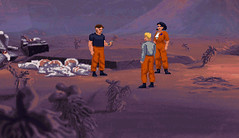 Classic!
Classic!
Desperate, Marooned Astronaut Tries To Use Every Item With Every Other Item
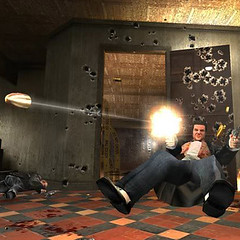 Scientific!
Scientific!
Report: One in Four Children Born With Ability To Slow Down Time
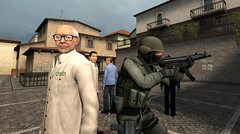 Touching!
Touching!
Hostages Rescued by Courageous Racist
And it’s some of the funniest games writing I’ve read all year. It’s pretty easy to come up with the idea of an Onion for gaming, but it’s harder than you’d think to flesh it out, keep it varied, and avoid driving the joke into the ground. Hardcasual exists, but it’s pretty hit-and-miss and focuses more on gaming news rather than news from within games.
The stories above are just my favourites: impressively there’s masses more to read already. I don’t know how regularly he plans on updating it, but I don’t think it needs to be frequent to work. It just needs to stay this good.
Fresh Fox
My browser had been acting weird since I tried – and uninstalled – Tab Mix Plus in the hope of solving an age old irritation with Firefox. I open everything in new tabs, and Javascript links wake up in this new existence with no clue to where they came from or what they were supposed to do. It didn’t work, and it made a lot of other things not work, so I started from scratch. Which really makes you realise the Firefox add-ons you can’t function without.
Adblock Plus
I was kind of amazed when I reinstalled Firefox once, and was shown a recommended add-ons window with this at number one. It’s not like the dark days when the original Adblock had to be manually supplimented with an external filterset for it to eliminate anything you didn’t specifically ask it to. These days this, the recommended add-on to the recommended browser for your PC, comes with a default evolving set of filters that rip out the ads that pay for the sites you use.
It’s unequivocally website piracy, and if it actually did become widespread, the internet would stop. There’d be nothing left. Just James, I guess, Wikipedia and Twitter. Those might have ads too, I wouldn’t know, I’ve been using Adblock a lot longer than them.
Still, until it’s illegal, I’m using it. I’m virtually a communist, I think advertising is fundamentally morally wrong and would be banned in any healthy society. Luckily, in mine, it is!
Greasemonkey
This does nothing in itself, but lets you install scripts that apply only to certain websites, and redesign them to your tastes. I use this almost solely to fuck with YouTube – the star script here adds a slick little Download button below every YouTube video, giving direct hard links to the source files for the clip in a variety of resolutions and formats.
Image Zoom
All the browsers are pretty good at dealing with images larger than your screen, but a more common problem is ones that are too small. Image Zoom lets you click both mouse buttons to blow an image up to the biggest it will go in the current window. Particularly good for animated GIFs.
InFormEnter
The only thing more useful than Adblock. You type some commonly needed stuff like your username, e-mail address, real address, maybe your low-security password, and in any form you can hit a key and select one of them from a list. I got to a point in my life when if I had to fill out my details on one more fucking sign-up form, I was going to prise my Tab key out with a screwdriver and try to cut my wrists with it. InformEnter was the alternative.
Intelligent Middle Clickums
Stupid name for an updated version of an outdated extension to solve my original problem: open Javascript links in a new tab in a way that actually fucking opens them in an actual new tab. It doesn’t work for everything, but it also doesn’t break your whole goddamn browser.
Mycroft Project
Not listed above since it’s not an add-on, but a search engine. You know you can set the search box in the top right to search different sites, like Wikipedia? Well, one of the sites you can set it to search is a site of sites to search with the search box you’re searching in. I use masses of these, and I’m thinking of new ones – like Play.com or Metacritic – all the time. Mycroft’s a place where users have rolled their own custom search engines for sites like that.
No Quicktime Plugin
I don’t know about you, but the only thing I want the built-in Quicktime plugin opening is the puzzle box from Hellraiser. But by default, Firefox won’t even give you the option to download dozens of different filetypes, assuming you’ll want to force them into a horribly stretched and barely functioning proprietary Apple product instead. I used to set all these manually to ‘save to disk’, but I’ve just discovered you can click the Plugins tab in the shot above, and disable it altogether.

